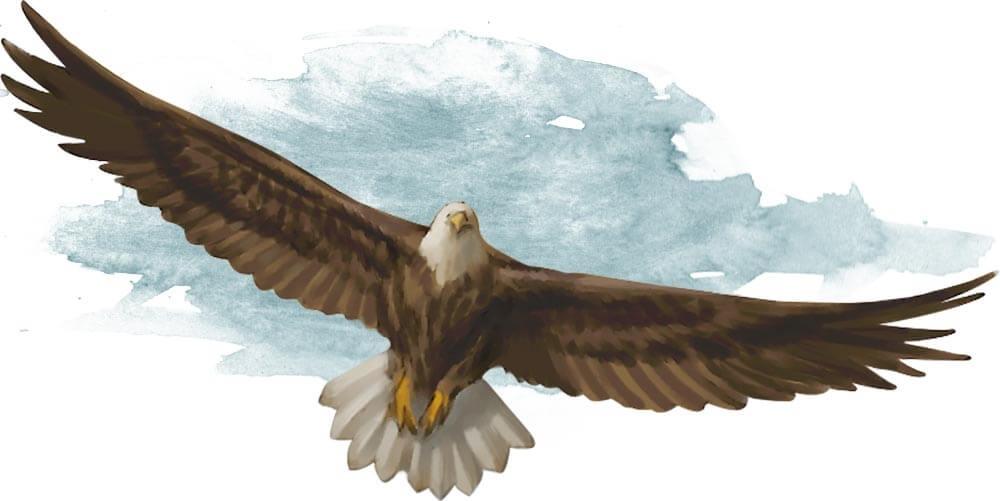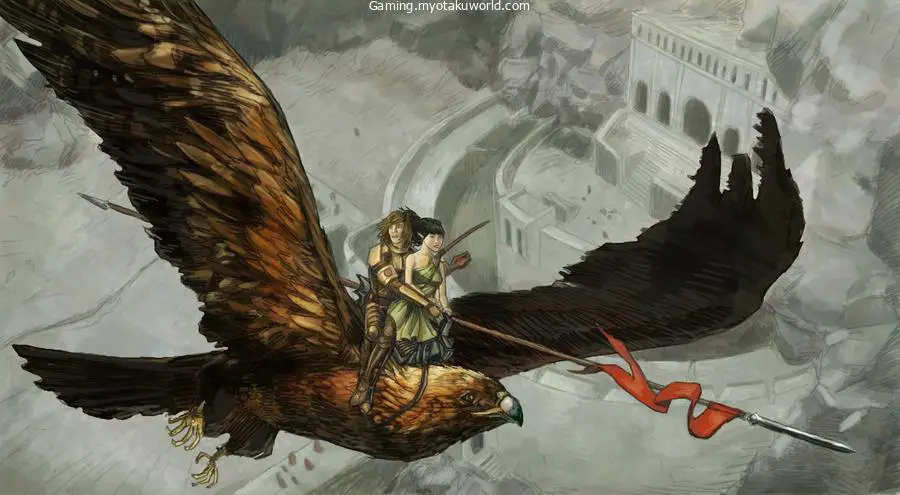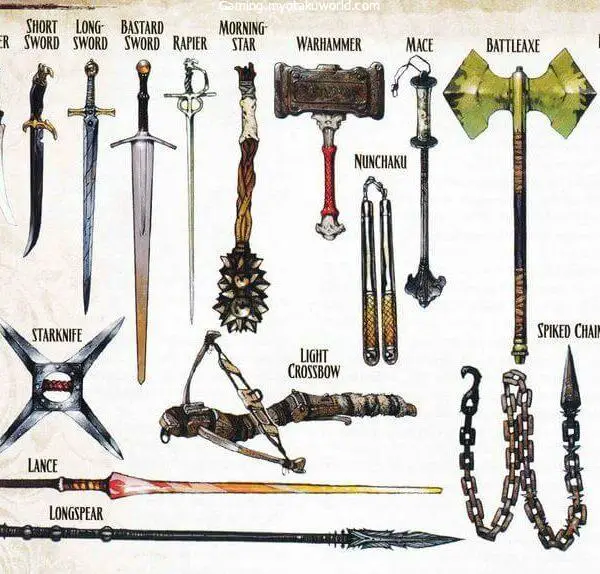The Bald Eagle is a fierce bird predator that deserves to be the fierce image of the United States of America. When they open their wings to fly, a majestic band that only they can hear sings and chants.
Every time they flap their wings, the sun gets brighter. Even though I’ve seen a lot of videos of animals being stupid, including the bald eagle, I still think of this bird as a fancy and smart animal of the skies.
But to smaller animals like mice and fish, bald eagles look like scary flying monsters with sharp beaks that can tear them to pieces. If we lived with the small creatures, we would have been just as scared of these birds.
In D&D 5e, though, you can experience what they did because you can meet huge birds that are as tall as houses.
The Giant Eagle in D&D 5e is a big creature that isn’t too different from bald eagles in real life (since Giant Eagles don’t exist in real life).
Their huge wings may scare and frighten you, but that doesn’t mean they are bad animals.
This Giant Eagle 5e Guide is for DMs who want to add them to their games and players who want to know how to beat them.
What is the Giant Eagle in D&D 5e?
Giant Eagles are big beasts that are neutrally good by default. They have an Armor Class of 13 and an average HP of 26. They can walk 10 feet per second and fly 80 feet per second.
They can talk in their own language, but they can also understand Common and Auran. But they don’t know how to speak these languages. They live on beaches, in fields, on hills, and in mountains.
On page 324 of the Monster Manual, you can find out more about them. Here are a few simple facts about this animal.
Huge Eagle
Size: Big
Type: Animal
Don’t Pay Good Armor is aligned in the middle. Grade: 13
26 Hit Points (4d10 + 4)
Speed: 10 feet when walking, 80 feet when flying.
Giant Eagle, Common (only understand), and Auran (only understand).
Coastal, grassland, hill, and mountain environments.
Read the next parts to learn more about what the Giant Eagle can do in battle.
Giant Eagle’s Ability Scores, Skills, and Senses

Here are the skill scores for the Giant Eagle.
Power: 16 (+3)
17 (+3) for dexterity
Articles: 13 (+1)
8 (-1) for intelligence
Smarts: 14 (+2)
10 (plus 0) for charm
The Giant Eagle’s ability scores show that it is a strong and quick creature, which is especially true when it is in the air. They are in good health, and they are very good at using their abilities.
Not surprisingly, they can’t charm anyone (unless you’re really into birds), and they can’t figure out what’s going on any better than other animals.
The only skill that the Giant Eagle is really good at is Perception. After all, the phrase “eagle eye” is used for a reason.
Their Perception is now +4 because their Wisdom is +2. Aside from passive Perception of 14, they don’t have any other special abilities.
Giant Eagle’s Abilities
Keen Sight is an ability of the Giant Eagle that gives it an edge on Wisdom (Perception) checks that require sight.
For example, a Giant Eagle that wants to use its sight to find a group of adventurers will roll two d20s and choose the better number. This perk will not work, though, if they try to figure out where you are.
Giant Eagle’s Actions
The Giant Eagle has one multi-attack and two weapon attacks. The weapon attacks are called “Beak” and “Talons.” During their turn, they can either do an attack or a multi-attack. The details of each move are listed below.
Giant Eagle’s Beak Attack
The Giant Eagle strikes with its beak, which is very sharp. If they are fighting someone smaller than them, it might look like they are pecking the ground.
Eagles usually have sharp beaks that they can use to bite their food in the head or neck to kill it right away. The good news is that this game is less harsh than real life.
Type of Attack: Melee
Change to the attack: +5
One goal is within five feet.
Damage: 1d6+3, with an average of 6
Type of damage: piercing
Giant Eagle’s Talons Attack
The Giant Eagle can also use its sharp claws as a weapon. If they attacked a smaller target, it would look like a chicken scratching the ground, like the Beak attack. Still, you can try to get rid of that picture and make it look cool.
Eagles have sharp claws so they can easily catch small animals as they dig into them, but this game isn’t as harsh as real life.
Type of Attack: Melee
Change to the attack: +5
One goal is within five feet.
Damage: 2d6 + 3 (an average of 10)
Type of damage: cutting
Giant Eagle’s Multi-attack
The Beak attack and the Talons attack are both part of the Giant Eagle’s multi-attack. In an ideal world, monsters would always use this move because it does more damage, and the Giant Eagle is no exception.
The DM picks whether they use the Beak attack or the Talons attack first. You can look at the parts before this one for more information about these attacks.
Giant Eagle’s Biology
Since Giant Eagles are listed under “other creatures,” their page doesn’t have much information about them. They are thought to be good people, which could be a mirror of what the Eagle means in real life.
People around the world admire and respect them in all of their different cultures. People think of eagles as being truthful, strong, brave, powerful, and free.
Giant Eagle’s Language
It has its own language, but it can also understand English, which sets it apart from other animals. But even though they can understand Common, they can’t say it because they don’t have the right vocal cords or genetics. If you talk to a Giant Eagle in Common, it will understand what you are saying, and if it respects you, it might even do what you say.
They can also understand Auran, which is an elemental creature’s version of the Primordial tongue. Auran is linked to the element of air or wind.
The fact that Giant Eagles can understand this speech makes sense, since they can fly. Aquan, which means “water,” Ignan, which means “fire,” and Terran, which means “Earth,” are also forms of the Primordial language.
Giant Eagle’s Behavior
Giant Eagles are neutral good by nature, so they would do whatever they thought was morally right without caring about the law. In a way, it only follows one rule: the law of nature. It does what its nature requires of it. Still, their Intelligence number might be the same as that of a person with poor logic.
In the wild, they make homes and have babies with other Giant Eagles. When you find a Giant Eagle nest, you will probably find about four eggs or young birds. But because Giant Eagles are so big, their young can be as big as those of regular-sized eagles when they hatch.
Giant Eagle’s Habitat
Giant Eagles can live near the coast, in fields, on hills, and in mountains because these places let them fly around freely. If you need to find a Giant Eagle (maybe for a quest), I’d suggest going to the plains because you might have trouble fighting in the hills and mountains.
The Giant Eagle has a big edge in these places. You will have trouble keeping your balance, but the Giant Eagle can just fly and glide through the air with ease. Giant Eagles can also find good places to hunt along the coast.
Giant Eagle’s Composition
Giant Eagles are very strong creatures. At best, they can have up to 44 HP, and at worst, they can only have up to 8. Most of them have 26 HP.
Their Armor Class, on the other hand, is not very good. It is 13, which means that players with good attack bonuses can easily break through it.
Since they can fly, they know how to control the air. But just because they are good at flying doesn’t mean they are good at walking.
In one turn, they can fly about 80 feet, which is about nine miles per hour. On the ground, however, they can only move 10 feet per turn, or 1.2 miles per hour.
How to Defeat the Giant Eagle in D&D 5e?
The Giant Eagle’s best qualities are its sharp eyes and fast flight. If you know you’re going up against a Giant Eagle, having spells or attacks that can make it fall over will give you a big edge, since a flying creature that falls over can’t move.
If a flying monster falls down, it will land on the ground. The Giant Eagle would have to fly back up 40 feet.
The Battle Master Fighter’s Trip Attack is a good example of this kind of move. You can spend a power die to try to knock your opponent down.
When it comes to spells, Command is a good one-level Enchantment spell that Clerics and Paladins can use. But Command might not work because the Giant Eagle has a high Wisdom score.
All of the Giant Eagle’s moves are close-range, so it’s best to stay away from close-range fights with them. If you keep your distance, making the Giant Eagle flip over often will make it hard for it to get close to you.
In this case, ranged strikes would be very helpful because you wouldn’t have to get close to the beast to hit it.
How to Use the Giant Eagle as DM in D&D 5e?
If you are a DM and you want your players to fight a Giant Eagle, make sure that the fight makes sense. For example, it makes sense for a Giant Eagle to show up in open places like fields or beaches, where it can move around freely. The fight will be harder for the players if it takes place in an area where the Giant Eagle can fly.
It will be hard for three level-one PCs (player characters) to beat a Giant Eagle, so I recommend having this fight with four or five level-one PCs.
But three level-two PCs should have no trouble beating up one. If the PC is level 4, a fight between it and a Giant Eagle will be fair. A level five PC should have no trouble beating a Giant Eagle.
If it’s too hard for your players to deal with the Giant Eagle, you can decide not to use the multi-attacks. You can instead use either the Beak or the Talons move.
FAQs
How Big are Giant Eagles in D&D 5e?
Giant Eagles are big creatures in D&D 5E. If you use square grids to show D&D battle, they take up four tiles. A person of average size, on the other hand, will only take up one tile.
HOW fast can a Giant Eagle fly in D&D 5e?
In D&D 5E, a Giant Eagle can fly at a speed of 80 feet per turn. It can fly up to nine miles per hour, but it can only walk 10 feet per turn, which isn’t very far.
What is the Giant Eagle’s carry capacity in D&D 5e?
In D&D 5E, a Giant Eagle can carry up to 480 lbs. The rules of carrying say that a person’s carrying ability is equal to their strength score times 15. With a 16 for power, a Giant Eagle would be able to lift 250 lbs. Also, the Giant Eagle is a big animal, and when compared to other big animals, you double that score. This means they can carry a total of 480 lbs.
What is the CR of a Giant Eagle in D7D 5e?
In D&D 5E, a giant eagle has a challenge level of 1, and killing one gives 200 XP.










Leave a Comment